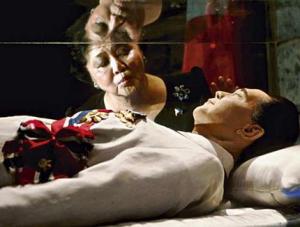For most of you, the names Ferdinand and Imelda Marcos won’t ring any bells. But from 1965 to 1986, Ferdinand was the President and Imelda the First Lady of the Philippines. In those 21 years, Ferdinand, with Imelda’s help, managed to rack up an astonishing record of abuses common to dictators – human rights violations, assassinations, corruption, embezzlement of public funds – and held onto power through the imposition of martial law, the abolition of the constitution, and the appointment of political cronies, including Imelda, a former beauty queen, to prominent posts.
Finally, in 1986, a people’s coup toppled the Marcos regime and the Marcoses were forced to flee their palace and the country. They were given safe passage by the Reagan Administration to Hawaii. In the palace, Imelda left behind 15 mink coats, 508 gowns, 888 handbags and 1060 pairs of shoes, some say 2700 pairs. It was estimated that the Marcos family was worth $35 billion.
Three years later, still in exile in Hawaii, Ferdinand was dead at 72 of complications from lupus. Imelda wanted Ferdinand to be buried in the Philippines but his body was refused entry. So Imelda kept the body in a refrigerated mausoleum in Oahu, complete with soft music, wheeling him out over the years for a birthday party and an anniversary celebration. (1) The power company soon threatened to suspend power for the costly tomb when thousands of dollars in electric bills went unpaid but, at the last minute, a friend came forward and picked up the tab.
In 2001, twelve years after his death, the Philippine government allowed Ferdinand’s corpse to return to his homeland and Imelda with it. Imelda went to work building a tomb in the national cemetery where Filipino heroes are buried. But fierce opposition broke out and blocked the former president’s burial. Ferdinand’s remains were then temporarily housed at a mansion in Batac, Ilocos Norte Province, in an air conditioned room. Eventually the corpse was moved to their present location in the Marcos family mausoleum in the village cemetery in Batac.

Former First Lady of the Philippines kisses the crystal coffin of her deceased husband, former President Ferdinand Marcos
The once-ruthless dictator is now a shrunken fellow dressed in a barong tagalog and black slacks lying in a glass viewing case inside a refrigerated crypt in a stone room with soft lights and church music. He is on perpetual view. A steady flow of visitors file past him. There his restless corpse will remain, above ground, unless Imelda gets her way and the government relents, according him a government-sponsored burial with full military honors.
A visitor to the mausoleum says that the corpse of Ferdinand Marcos, according to Filipino burial tradition, lies shoeless in the coffin. He swears that Marcos’ face and hands, however, don’t look very natural, even for a corpse. Speculation is that the real corpse is under the glass coffin, and that the figure on display is a dummy. The family claims this is not so, that the corpse looks waxy because it has to be waxed periodically for preservation.
(1) Verdery, Katherine. The Political Lives of Dead Bodies. (New York: Columbia University Press, 2000)

0 comments:
Post a Comment